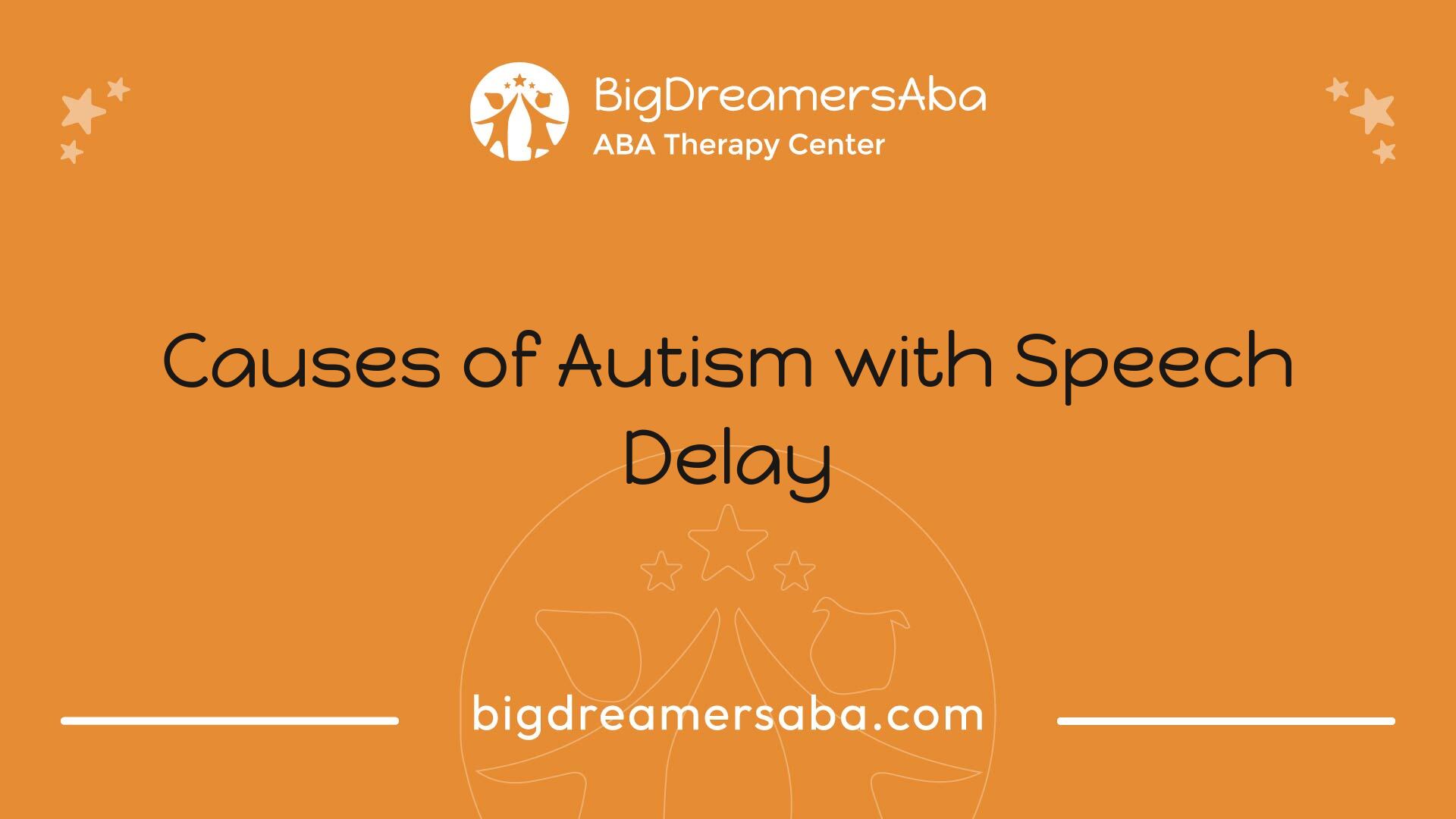Coping with Autism and Speech Delay
Explore autism with speech delay, from signs to treatment, and empower communication and understanding!


Understanding Autism with Speech Delay
Understanding the relationship between autism and speech delay is essential for caregivers and educators. This section will clarify the differences between speech delays and autism, as well as outline the signs that may indicate a speech delay related to autism.
Differentiating Speech Delays and Autism
Speech delays refer specifically to challenges in developing speech and language skills that can occur for various reasons, while autism spectrum disorder (ASD) is a neurological disorder that affects social skills, learning, communication, and behavior.
CharacteristicSpeech DelayAutism Spectrum DisorderCommunication SkillsOften uses body language and eye contact naturallyMay struggle with social interaction and nonverbal cuesSocial RelationshipsSeeks close personal relationships with parents and peersMay prefer solitude and have difficulty forming relationshipsDevelopment by Age 2Signs of delayed speech but can show typical social interactionsTypically shows signs of delayed development, particularly in language and social skills
Children with autism may have difficulty with communication and may not show the same eagerness to use language as those simply experiencing a speech delay.
Signs of Autism-Related Speech Delay
Autism-related speech delays can manifest in various ways. Early indicators before the age of 2 can include:
Children often face difficulty with social interaction and may show a preference for solitary play. Recognizing and addressing these signs early is critical, as the acquisition of language during early childhood is a strong predictor of long-term outcomes for those with autism, particularly focusing on language production as a key area for intervention [2].
Speech therapy can be an effective approach to assist children with autism or speech delays in developing their communication skills [1]. Identifying these challenges early facilitates beneficial support tailored to the individual needs of the child.
Causes of Autism with Speech Delay

Understanding the causes of autism with speech delay involves examining both genetic and environmental factors. These influences can contribute to the complex interplay that affects speech development in individuals with autism.
Genetic Influences
Genetic factors are believed to be primary contributors to autism with speech delay. Certain genetic variations and mutations can significantly increase the risk of developing autism. These genetic anomalies affect brain development, leading to challenges in speech and communication.
Research indicates that children with a family history of autism have a higher likelihood of experiencing speech delays. In fact, studies have shown that siblings of children diagnosed with autism often exhibit language and gestural communication delays, which could serve as early indicators of potential speech issues later in life [4].
FactorDescriptionGenetic VariationsMutations that affect brain development and functionFamily HistoryIncreased risk in children with siblings diagnosed with autism
Environmental Factors
Environmental influences during early brain development also play a significant role in the manifestation of autism with speech delay. Prenatal and perinatal factors, including maternal infections, exposure to environmental toxins, and complications during pregnancy or birth, are studied as potential risk factors [3].
Differences in neural functional connectivity related to speech and language processing have been observed early in infants at high risk for autism spectrum disorders (ASD). These alterations in connectivity patterns can be predictive of later speech challenges. High-risk infants may show reduced functional connectivity in crucial areas of the brain responsible for language, with these differences becoming more apparent over time.
Environmental FactorPotential InfluenceMaternal InfectionsMay hinder healthy brain developmentExposure to ToxinsCan impact neurological developmentPregnancy ComplicationsRelated to increased risk for ASD
Maternal contributions to early communication interactions are pivotal for language development, particularly in infants at risk for ASD. Abnormalities in mother-infant interactions, such as less sensitive communication styles, may influence language outcomes as well. Variability in infant behaviors like attention and communicative attempts also significantly affects their ability to develop speech [4].
By examining both genetic and environmental factors, one can gain insight into the complex nature of autism with speech delay and its various contributing elements. For more information on diagnosis and evaluation, refer to our section on [Diagnosis and Evaluation]().
Early Detection and Intervention

Early detection and intervention are critical components when addressing autism with speech delay. Recognizing signs and providing support as soon as possible can significantly improve a child's developmental trajectory.
Importance of Early Intervention
Early intervention is essential for children with autism to aid in diagnosing the condition and treating related speech delays. Research indicates that timely intervention strategies enhance a child's development, concentrating on communication and other key developmental areas. Noticing potential indicators by age two can pave the way for effective support.
For example, a child with autism may exhibit delays in language development compared to their peers. Early intervention can include various therapies and strategies tailored to individual needs, which can help these children catch up with their milestones.
AgeMilestonesSigns of Delayed Development1 YearFirst wordsNo babbling or single words2 YearsTwo-word phrasesInability to combine words3-4 YearsSimple sentencesDifficulty in initiating conversation
Role of Speech Therapy
Speech therapy plays a key role in supporting individuals with autism and speech delays. This intervention focuses on enhancing communication skills including speech production, language comprehension, and social communication. Speech therapists assess each child's specific needs and design personalized programs to improve their communication abilities.
In many cases, children with autism may exhibit inappropriate, unexpressive, or stilted communication patterns. They often face challenges such as initiating or maintaining conversations, using a robotic voice, echolalia (repeating phrases without context), and finding difficulty in constructing meaningful sentences. Speech therapy is tailored to address these specific challenges, helping children develop healthier communication patterns.
Moreover, the benefits of speech therapy extend beyond mere verbal communication. Early intervention through online speech therapy provides flexibility and accessibility, allowing children to engage in therapy sessions from home. This approach has been shown to foster self-expression, improving overall communication skills.
In exploring treatments for autism, including speech delay, a multidisciplinary approach that incorporates various therapies can provide comprehensive support for affected children, ultimately leading to improved outcomes in their social interactions and communication skills.
Diagnosis and Evaluation
Effective diagnosis and evaluation are essential components in managing autism with speech delay. This process involves a thorough assessment by multiple professionals to ensure accurate identification and appropriate intervention strategies.
Multidisciplinary Evaluation
A multidisciplinary evaluation is a comprehensive approach that involves various specialists, including speech-language pathologists, psychologists, pediatricians, and other experts. This collaborative effort is crucial for accurately diagnosing individuals with autism and speech delay. The evaluation process considers the unique characteristics and circumstances of each individual, leading to more effective and personalized treatment plans [3].
In a typical multidisciplinary evaluation, the following professionals may be involved:
ProfessionalRoleSpeech-Language PathologistAssesses communication skills, speech production, and language comprehensionPsychologistEvaluates behavior and cognitive functioningPediatricianConducts a medical assessment and reviews developmental historyOccupational TherapistExamines daily living skills and sensory processingSpecial EducatorProvides insight into learning and educational needs
Tailored Treatment Plans
Once a diagnosis is established through a multidisciplinary evaluation, tailored treatment plans are developed. These plans consider the individual’s specific needs, strengths, and challenges. For individuals with autism and speech delay, interventions may include speech therapy, behavioral therapy, and educational supports focused on enhancing communication skills and social interaction [3].
Speech therapy, in particular, is key in addressing communication deficits. It focuses on improving various skills including:
Skill AreaFocusSpeech ProductionEnhancing articulation and clarity of speechLanguage ComprehensionImproving understanding of language and following directionsSocial CommunicationDeveloping conversational skills and understanding social cues
Each treatment plan is unique and frequently adjusted based on the individual’s progress and response to interventions. Continuous monitoring and evaluation allow for necessary modifications to ensure the effectiveness of the treatment approach.
Incorporating insights from varied disciplines supports a more holistic understanding of the individual's needs, ultimately leading to improved outcomes. For further reading on the differences between autism and other disorders, consider articles such as autism vs. ADHD or autism vs. Down syndrome.
Communication Challenges in Autism
Children with autism often face significant communication challenges, particularly in the areas of language development and social interaction. Understanding these challenges is essential for providing the appropriate support.
Language Development Delays
Language development delays are common in children with autism. These delays can manifest in various ways, including difficulty in initiating or maintaining conversations, using a robotic voice, and echolalia, which involves repeating words or phrases without context [6]. Additionally, many children struggle to combine words into meaningful sentences.
Here are some specific characteristics observed in children with language development delays related to autism:
CharacteristicsDescriptionSingle WordsOften speaking in isolated words instead of phrases.Repetitive PhrasesFrequently repeating phrases or words from others.Limited ExpressivenessExhibiting stilted or unexpressive communication.Object LabelingCompulsively labeling objects rather than commenting or requesting.
This type of communication challenge can lead to frustration, both for the child and caregivers, and may require targeted interventions to facilitate better language skills.
Social Communication Issues
Social communication issues are also prevalent among children with autism. These challenges make it difficult for them to engage meaningfully with others. They may stare through individuals rather than making eye contact and have trouble understanding the nuances of social cues such as tone of voice and facial expressions.
Common social communication difficulties include:
IssuesDescriptionDifficulty with Turn-TakingStruggling to understand when to speak and listen.Limited Response to QuestionsOften answering with single-word replies or not at all.Challenges in UnderstandingDifficulty comprehending social norms and expectations.
These factors can hinder a child's ability to make friends and develop social skills. Addressing these social communication issues often requires the involvement of speech-language therapy and social skills training.
The interplay between language development delays and social communication issues makes navigating interactions particularly tough for children with autism. Early detection, intervention, and tailored strategies are crucial for enhancing communication skills and fostering better relationships with peers and family members. For additional insight into treatment methods, refer to our section on treatment approaches for autism.
Treatment Approaches for Autism
Effective treatment of autism with speech delay often involves a combination of various therapeutic approaches. Two of the most common methods are behavioral therapy and speech-language therapy.
Behavioral Therapy
Behavioral therapy is a widely used treatment for Autism Spectrum Disorder (ASD) that aims to encourage desired behaviors while reducing unwanted behaviors. This therapy often employs techniques from applied behavior analysis (ABA). Positive reinforcement is a key component, helping children understand the connection between their actions and the resulting consequences.
Moreover, Pivotal Response Treatment (PRT) is a play-based approach that also follows the principles of ABA. PRT focuses on pivotal areas such as motivation, self-management, and initiating social interactions. By targeting these essential skills, PRT helps improve social competence and communication abilities in children with autism.
Behavioral Therapy TypeGoalsTechniques UsedTraditional ABAIncrease positive behaviors, decrease negative onesPositive reinforcement, modification of environmentPivotal Response Treatment (PRT)Improve social interactions and communicationPlay-based activities, focusing on motivation
Speech-Language Therapy
Speech-language therapy is crucial for assisting children with ASD in enhancing their verbal and nonverbal communication skills. This therapy addresses various aspects of speech, such as improving sentence structure, vocabulary, and the rhythm of speech. Tailored exercises focus on enhancing the ability to express feelings and interact socially.
In addition to verbal skills, speech-language therapy can incorporate nonverbal communication methods, including teaching sign language or using alternative communication systems. These interventions provide children with multiple channels to communicate effectively.
Speech-Language Therapy FocusGoalsExpected OutcomesVerbal SkillsImprove articulation and vocabularyEnhanced ability to express thoughtsNonverbal CommunicationTeach alternative methods like sign languageIncreased options for communication
Both behavioral therapy and speech-language therapy offer valuable support for children with autism, particularly those experiencing speech delays. For individuals seeking to learn more about autism evaluation, consider visiting our article on are online autism tests accurate?, which provides insights into assessment and diagnosis.
References
[2]:
[3]:
[4]:
[5]:
[6]:
Recent articles

ABA Techniques for Picky Eaters: Building Better Habits

How Social School Support Makes School Transitions Easier for Children
